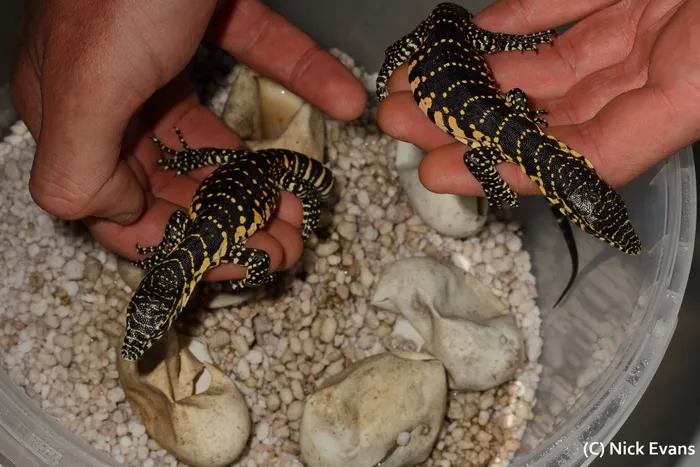LOOK: Eggs laid by pregnant Nile monitor lizard rescued in uMlazi have hatched

Data such as weight and length were collected from all the lizards. Picture: Nick Evans
Durban — The eggs hatched from a pregnant Nile monitor lizard that was rescued in uMlazi in June have hatched and their rescuer was there to witness it.
On Monday, rescuer Nick Evans said that he has been fortunate to witness many species of snakes hatch but this was something different and very special.
In June one night, Evans and researcher Euan Genevier went to uMlazi to fetch a Nile monitor lizard (also known as uXamu, likkewaan, woodumboo), which had been digging in a retaining wall for days.
After taking the lizard to the South African Association for Marine Biological Research (Saambr), for the veterinary and Dangerous Creatures (DC) team to check out, it was soon concluded that she was egg-bound and needed some assistance. With fluids and medication, she eventually laid her eggs later that month. The eggs were placed in an incubator, and the mother was released.

Evans said that last week, while he was at Dangerous Creatures having an injured black mamba checked out, a staff member checked on the eggs.
“Some of the little lizards had already hatched, while others had torn open their leathery eggshells, readying themselves to start their lives. It was so exciting, and a massive relief, as we had been nervously waiting for this moment, worried none would hatch (more out of anxiety),” Evans said.

“The monitor’s forked, snake-like tongue would flicker out the tear in the eggshell. Their keen senses were already working very well, reacting to us moving. These lizards have an excellent sense of smell and vision.
“The snout would slowly appear, then more of the head. As the young lizard looked around, once deciding it was safe enough to fully emerge, it did. The bright, yellow and black colours were strikingly beautiful. They were less than 30cm, and so, so cute!” Evans said.
“For the first few minutes after hatching, these little lizards were extremely docile, which was surprising, as they are normally extremely defensive when handled. However, that defensive nature soon kicked in.”

He said they were relieved with the small win for lizard conservation.
“Thank you to the Dangerous Creatures team for incubating the eggs!”
Data such as weight and length were collected from all the lizards before their release.

Evans described releasing the 15 hatched lizards as “a really special experience”.
He said that almost always, when one releases one of these lizards, they bolt into the water or bush, and you do not see them again. They expected the same would happen with the juveniles too.
“Well, we got to watch these little ones climb up onto the reeds, swim around, and find their way around their new environment. I wish more releases went like that,” Evans exclaimed.

He explained that at this size and age, they would feed on insects, small frogs, and anything smaller than them. They would have predators in the form of birds, water mongoose and larger monitor lizards.
“But that's nature, that's the food chain,” Evans said.
He said that some may wonder if it would be kinder to keep the lizards until they were bigger.

“Keeping them, raising them till they were bigger, or till they were adults, would be nice, but flawed. Keeping them for long periods of time, they could pick up a disease in captivity that could be harmful to wild lizards, once the captive animals were released,” Evans explained.
“This species is also notorious for not doing well in captivity, as they stress and never settle. Practically, it is difficult, because they will require a fair amount of space as they grow.

“Being a protected species, permission from authorities and permits would be required, and that could be tricky,” Evans said.
“Also, not all wild animals survive to adulthood for a reason. If they did, there would be too many of one particular animal, and that’s never a good thing from an ecological point of view.”
Evans said that releasing them immediately was without a doubt the correct decision. Conservation requires tough calls a lot of the time, where one has to separate emotion from decision making, which is tough to do.

If it were not for the veterinary and Dangerous Creatures teams at Saambr, the mother lizard would have died without laying her eggs. Instead, the mother survived her ordeal, got a second chance in the wild, and her offspring were given a good chance at life.
“I am so grateful to them,” Evans said.



WhatsApp your views on this story at 071 485 7995.
Daily News
Related Topics: